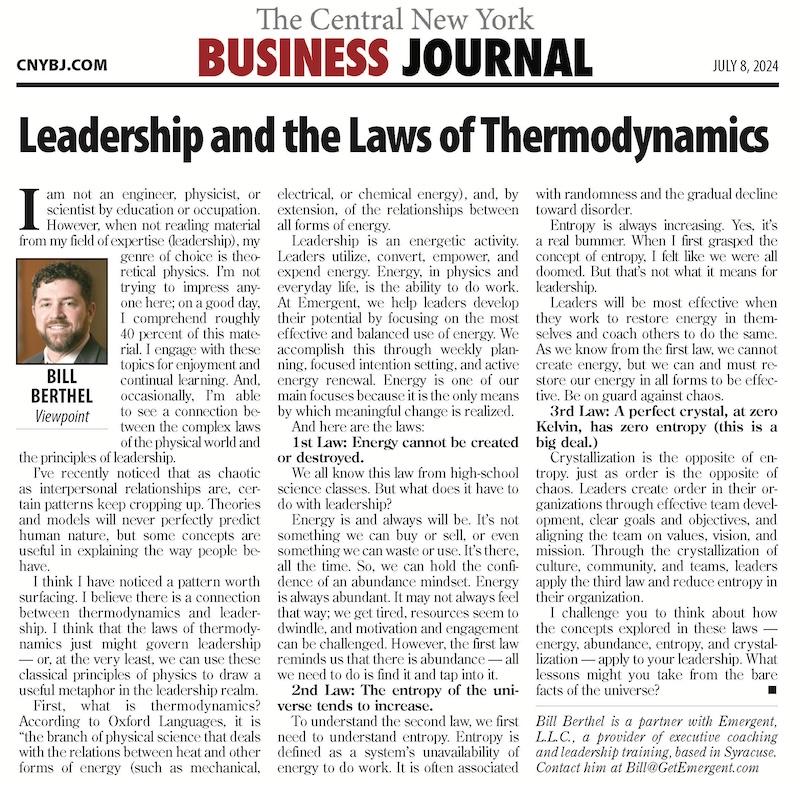I am not an engineer, physicist or scientist by education or occupation. However, when not reading material from my field of expertise (leadership), my genre of choice is theoretical physics. I’m not trying to impress anyone here; on a good day, I comprehend roughly 40% of this material! I engage with these topics for enjoyment and continual learning. And, occasionally, I’m able to see a connection between the complex laws of the physical world and the principles of leadership.
I’ve noticed recently that as chaotic as interpersonal relationships are, certain patterns keep cropping up. Theories and models will never perfectly predict human nature, but some concepts are useful in explaining the way people behave.
I think I’ve noticed a pattern worth surfacing. I believe there is a connection between thermodynamics and leadership. I think that the laws of thermodynamics just might govern leadership…or, at the very least, we can use these classical principles of physics to draw a useful metaphor in the leadership realm.
First, what is thermodynamics? According to Oxford Languages, it is ”the branch of physical science that deals with the relations between heat and other forms of energy (such as mechanical, electrical, or chemical energy), and, by extension, of the relationships between all forms of energy.
Leadership is an energetic activity. Leaders utilize, convert, empower and expend energy. Energy, in physics and everyday life, is the ability to do work. At Emergent, we help leaders develop their potential by focusing on the most effective and balanced use of energy. We accomplish this through weekly planning, focused intention setting, and active energy renewal. Energy is one of our main focuses because it is the only means by which meaningful change is realized.
And here are the laws:
1st Law: Energy cannot be created or destroyed.
We all know this law from high school science classes. But what does it have to do with leadership?
Energy is and always will be. It’s not something we can buy or sell, or even something we can waste or use. It’s there, all the time. So, we can hold the confidence of an abundance mindset. Energy is always abundant. It may not always feel that way; we get tired, resources seem to dwindle, and motivation and engagement can be challenged. However, The 1st Law reminds us that there is abundance–all we need to do is find it and tap into it!
2nd Law: The entropy of the universe tends to increase.
To understand the 2nd law, we first need to understand entropy. Entropy is defined as a system’s unavailability of energy to do work. It is often associated with randomness and the gradual decline toward disorder.
Entropy is always increasing. Yes, it’s a real bummer. When I first grasped the concept of entropy, I felt like we were all doomed! But that’s not what it means for leadership.
Leaders will be most effective when they work to restore energy in themselves and coach others to do the same. As we know from the 1st Law, we cannot create energy, but we can and must restore our energy in all forms to be effective. Be on guard against chaos!
3rd Law: A perfect crystal, at zero Kelvin, has zero entropy (this is a big deal!)
Crystallization is the opposite of entropy. just as order is the opposite of chaos. Leaders create order in their organizations through effective team development, clear goals and objectives, and aligning the team on values, vision, and mission. Through the crystallization of culture, community, and teams, the leader applies the 3rd Law and reduces entropy in their organization.
I challenge you to think about how the concepts explored in these laws–energy, abundance, entropy, and crystallization–apply to your leadership. What lessons might you take from the bare facts of the universe?
This Viewpoint originally appeared in the Central New York Business Journal on July 8, 2024.

Comments (0)